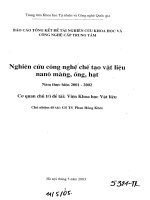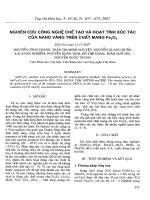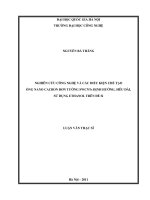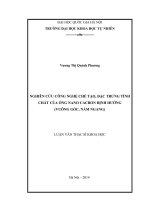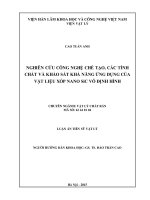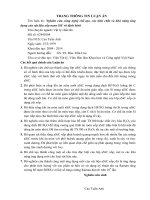- Trang chủ >>
- Khoa Học Tự Nhiên >>
- Vật lý
Tiny silicon nano wires synthesis on silicon wafers
Bạn đang xem bản rút gọn của tài liệu. Xem và tải ngay bản đầy đủ của tài liệu tại đây (300.31 KB, 5 trang )
Physica E 24 (2004) 328–332
Tiny silicon nano-wires synthesis on silicon wafers
Junjie Niu
a
, Jian Sha
a,b
, Yujie Ji
a
, Deren Yang
a,Ã
a
State Key Laboratory of Silicon Materials, Zhejiang University, Hangzhou 310027, People’s Republic of China
b
Department of Physics, Zhejiang University, Hangzhou 310027, People’s Republic of China
Received 20 April 2004; accepted 10 June 2004
Available online 11 August 2004
Abstract
Tiny silicon nano-wires (SiNWs) were synthesized on silicon wafers by the chemical vapor deposition (CVD)
technique. The morphology and structure of tiny SiNWs were analyzed by means of transmission electron microscopy
(TEM), scanning electron microscopy (SEM) and X-ray diffraction (XRD), respectively. The results indicate that the
tiny SiNWs were part-crystalline structure and were about 3 nm in minimal diameter. Based on the line shift of Raman
spectra, the structure transform of the tiny SiNWs was discussed. The defect-inducing growth mechanism will probably
provide a new method for the minimum of the one-dimensional nano-materials.
r 2004 Elsevier B.V. All rights reserved.
PACS: 71.55.Cn; 81.05.Ys
Keywords: Nano-wires; Synthesis; Silicon
1. Introduction
One dimension nano-materials have stimulated
much interest for their potential applications in
nano-electronics, optics, flat face display, etc.
[1–6]. Many techniques are employed to fabricate
one-dimension nano-materials, such as laser abla-
tion, chemical vapor deposition (CVD), physical
vapor deposition, aqua-solution method, sputter
deposition, etc. [7–16]. Especially, the research
emphases have focused on the growth character-
istics [17] diameter minimum [18,19]. Recently Hu
et al. fabricated the silicon nanowires with
diameters of 10–30 nm sub-grow on the surface
of large amorphous SiO
2
nanowires with diameters
of 200–400 nm using floating-zone (FZ,
1233–1273 K) melt-vapor method [20]. And the
Silicon nano-wires (SiNWs) grown on silicon
wafers have also attracted much attention because
of their potential compatibility in the miniaturiza-
tion of integrated circuit (IC) [21–23]. But the
previous methods either cannot get the very thin
ARTICLE IN PRESS
www.elsevier.com/locate/physe
1386-9477/$ - see front matter r 2004 Elsevier B.V. All rights reserved.
doi:10.1016/j.physe.2004.06.041
Ã
Corresponding author. Tel: +86-571-87951667; fax: +86-
571-87952322.
E-mail address: (D. Yang).
wires or introduce the other substances such as
polymers. Also the process is complex and
expensive.
In this paper, we synthesized the very thin and
long large-scale part-crystalline SiNWs branch
with diameters of about 3–8 nm sub-grow on the
main well-crystalline SiNWs with diameters of
about 40–50 nm growing on silicon wafers by a
simple physical vapor deposition. The transmis-
sion electron microscopy (TEM) and scanning
electron microscopy (SEM) images of the SiNWs
displayed the appearance and surface pattern. The
X-ray diffraction (XRD) and selected area electric
diffraction (SAED) gave an obvious well-crystal-
line structure data of the SiNWs. Also the Raman
scattering spectra of the SiNWs indicated the
optical properties related to temperature depen-
dence on laser heating and the small size effect.
Furthermore, the growth mechanism was also
simply discussed.
2. Experimental
Tiny SiNWs were prepared on a heavily doped
p-type (1 1 1) silicon wafer with a resistivity of
about 0:001 O cm as substrate by means of a CVD
process. First, a magnetic sputtering technique was
used to deposit gold as a catalyst on the silicon
substrate (the thickness of Au film is $
100–200 nm). The substrate was then placed in a
quartz tube furnace, which was pumped down to
10 Pa. When the temperature reached 630 1C, a
mixture gas of argon, hydrogen, and silane with
the ratio of 100:20:15 was allowed into the
chamber. The pressure and temperature in the
chamber were kept at 1450 Pa and 630 1C during
the deposition. After the deposition, the substrate
was removed from the furnace and was investi-
gated by means of XRD (Rigaku, D/MAX 2550
PC), a Raman scattering spectroscope (Nicolet
Almega) and a SEM (JEOL, JSM-5610LV),
respectively. And then, the deposited matters on
the substrate were dissolved in an ethanol solution.
Finally, the solution was placed dropwise on a
copper grid, which was covered with a very thin
carbon film, so that the deposited materials could
be analyzed with TEM (200 kV, Phillip CM200)
equipped with an energy-dispersive X-ray spectro-
meter (EDX).
3. Results and discussion
Top view SEM image of the SiNWs grew on the
silicon substrate is shown in Fig. 1. A large
quantity of long and thick SiNWs (trunk SiNWs)
were observed on the surface of the silicon wafer.
The TEM images (Fig. 2) indicate a plenty of tiny
SiNWs attached on the top of a thick SiNW. They
are about 3–8 and 40–50 nm in diameter, respec-
tively. And the holistic SiNWs have a well
crystalline structure (the Si (1 1 1) direction is
indicated in the upper left of the Fig. 2). The TEM
image in Fig. 3a shows a large scale tiny SiNWs.
And the chemical characterizations of the SiNWs
using EDX show that they are composed of silicon
with neglectable traces of oxygen (Fig. 3b). It can
be seen that Si, Cu and O with smaller quantity
were mainly detected. Obviously the intensity of
the Si is the strongest among these peaks. Cu peak
came from Cu grid for TEM analysis, and O peak
mainly from the weak surface oxidation of nano-
wire or adsorption of oxygen on the nano-wire
because of the impure fixed gases and low vacuum
system. This means that the very tiny wires were
mainly composed of silicon core and a small
quantity of silicon oxide sheath. Detailed analysis
ARTICLE IN PRESS
Fig. 1. Top view SEM image of the SiNWs grew on the silicon
substrate (the part of Au nanoparticles was pointed by white
arrows).
J. Niu et al. / Physica E 24 (2004) 328–332 329
on the lattice images of the tiny SiNWs gives an
inter-planar spacing of 0.314 nm completely
corresponding to that of Si (1 1 1) planes by the
HRTEM in Fig. 3a. It was seen that the tiny
SiNWs have a double-layer nature with a crystal-
line silicon core and an amorphous SiO
2
outer
shell just like the Hu reported [20]. And the XRD
data in Fig. 4 showed that the Si peaks were very
strong with the Si (1 1 1), Si (2 2 0), and Si (3 1 1).
The intensity indicated the Si (1 1 1) is the possible
leading growth direction of the SiNWs. The Au
peaks in the figure come from the catalyst film for
the preparation of the sample (the images of Au
tips attaching to the SiNWs are shown in Fig. 1
and 2). The remarkable crystalline structure of the
SiNWs was confirmed clearly by above XRD data.
Here we briefly develop the defect-inducing growth
mechanism of the silicon wires based on the
previous reports [20,24]. According the vapor–li-
quid–solid (VLS) mechanism, the catalyst can
induce the deposition atoms to form a droplet
and grow nano-wires. The mostimportant is the
size and state of the catalyst which would play a
key effect on the quantity and diameter size of the
wires. In our experiments, the size of most
catalysts is very small and uniform. This con-
tributes the small catalyst particles to easily form
the nucleating point with the deposited atoms and
come into a wire. Once the trunk SiNWs formed,
high surface density of the SiNWs and the unstable
growth surroundings lead to a plenty of faults and
defects such as oxygen vacancies produce. The
properties of the silicon wafer also express some
effects in the form of these defects in our
experimentation. The existence of these defects
provides a good new nuclear center and will form a
wire to continue to grow with the more silicon
atoms joining in at low temperature. The new
nano-droplet composed of defects and silicon
atoms is easier to reach supersaturation to grow
ARTICLE IN PRESS
Fig. 2. TEM image of the SiNWs. The diameter of the trunk
SiNW is about 40 nm. The diameters of plenty of tiny SiNWs,
which attach on the tip, is about 3 nm. The upper left inset is the
SAED image of the same SiNWs.
Fig. 3. HRTEM image of tiny SiNWs (the inset is the TEM
image of the large scale of tiny SiNWs) (a) and the EDX
spectrum of the SiNWs (b). In the EDX spectrum, the Si, Cu
and O with smaller quantity were detected. Obviously the
intensity of the Si is the strongest among these peaks. Cu peak
came from Cu grid, and O peak mainly from the possible weak
surface oxidation of SiNWs during the synthesis or the
adsorption of oxygen on the SiNWs due to the survived oxygen
in TEM system.
30 40 50 60 70
10
20
30
40
50
60
70
Au
SiNWs
Au(220)
Au(200)
Au(111)
Si(311)
Si(220)
Si(111)
Intensity
2 Theta
(
de
g
ree
)
Fig. 4. XRD data of the SiNWs.
J. Niu et al. / Physica E 24 (2004) 328–332330
SiNW because of the lower energy compared with
the Au–Si droplet. Here the growth procedure can
be regarded as the developed VLS model with the
defects as catalyst but the metal. As the inter-
planar spacing of Si (1 1 1) planes needs low-energy
to form the crystalline array at a relatively low
temperature, finally the Si (1 1 1) dominates the
main growth direction just as the SAED and XRD
data showed. Here one case must be mentioned,
because the form of the tiny SiNWs was effected
by the properties of the defects, new nucleation
density, and other surrounding conditions, the
quantity of the tiny SiNWs is lesser compared with
the thick SiNWs.
We carried out Raman spectrum at room
temperature at an excitation wavelength of
532 nm. In Fig. 5, the characteristic peaks of
SiNWs at 494 and 480 cm
À1
with a clearly broad
downshift of nearly 35 cm
À1
compared with the
bulk silicon of 523 cm
À1
. Such a feature could be
due to different temperature dependence on laser
heating and the small size effect of SiNWs [25,26].
The peak of 480 cm
À1
and asymmetry of the peak
should contribute to the thin SiO
x
sheath out of
the silicon nano-wire and the defects which are
contained among the silicon nano-wire.
4. Conclusions
In conclusion, we have synthesized large-scale,
very tiny, and very long SiNWs on the substrate of
p-Si (1 1 1) wafer using the simple approach of
CVD method at 630 1C. The part-crystalline tiny
SiNWs with diameters of 3–8 nm sub-grow on the
trunk crystalline SiNWs with diameters of
40–50 nm. The defect-inducing growth mechanism
explained the growth of the tiny SiNWs at low
temperature. The deeper understanding of the
growth mechanism of the tiny SiNWs might
contribute a good suggestion for the successful
synthesis and device application of smaller one-
dimensional quantum wires. In the end, the
Raman spectra of the SiNWs were discussed. This
also shows a potential application in optical
waveguide of the nano-wires in the future.
Acknowledgements
This work was supported by the National
Natural Science Foundation of China (Project
No. 50272057) and the key project of Chinese
Ministry of Education. The authors would like to
thank Mr. X.R. Huang and Z.C. Chen, Zhejiang
University, for their helps with Raman spectrum.
References
[1] Y.N. Xia, P.D. Yang, Y.G. Sun, Y.Y. Wu, B. Mayers, B.
Gates, Y.D. Yin, F. Kim, H.Q. Yan, Adv. Mater. 15
(2003) 353.
[2] X. Zianni, A.G. Nassiopoulou, Phys. Rev. B 66 (2002)
205323.
[3] D.D.D. Ma, C.S. Lee, Y. Lifshitz, S.T. Lee, Appl. Phys.
Lett. 81 (2002) 3233.
[4] M. Fujii, A. Mimura, S. Hayashi, Phys. Rev. Lett. 89 20
(2002) 206805.
[5] Z.L. Wang, Adv. Mater. 15 (2003) 432.
[6] W.J. Zhao, A. Sawada, M. Takai, J.J. Appl. Phys. 41
(2002) 4314.
[7] J. Sha, J.J. Niu, X.Y. Ma, J. Xu, X.B. Zhang, Q. Yang,
D.R. Yang, Adv. Mater. 14 (2002) 1219.
[8] J.J. Niu, J. Sha, X.Y. Ma, J. Xu, D.R. Yang, Chem. Phys.
Lett. 367 (2003) 528.
[9] H. Zhang, X.Y. Ma, J. Xu, J.J. Niu, J. Sha, D.R. Yang,
J. Crys. Growth 246 (2002) 108.
[10] S. Sharma, M.K. Sunkara, Nanotechnology 15 (2004) 130.
ARTICLE IN PRESS
Fig. 5. Raman scattering of the SiNWs.
J. Niu et al. / Physica E 24 (2004) 328–332 331
[11] C.P. Li, X.H. Sun, N.B. Wong, C.S. Lee, S.T. Lee, Boon
K. Teo, Chem. Phys. Lett. 365 (2002) 22.
[12] J.J. Niu, J. Sha, Y.W. Wang, X.Y. Ma, D.R. Yang,
Microelectronic Eng. 66 (2003) 65.
[13] T. Hanrath, B.A. Korgel, Adv. Mater. 15 (2003) 437.
[14] Y. Cui, C.M. Lieber, Science 291 (2001) 851.
[15] Y.F. Zhang, Y.H. Tang, N. Wang, C.S. Lee, I. Bello, S.T.
Lee, J. Crys. Growth 197 (1999) 136.
[16] A. Leonhardt, M. Ritschel, R. Kozhuharova, A. Graff, T.
Muhl, R. Huhle, I. Monch, D. Elefant, C.M. Schneider,
Diam. Rel. Mater. 12 (2003) 790.
[17] K.K. Lew, J.M. Redwing, J. Crys. Growth 254 (2003) 14.
[18] N. Wang, Z.K. Tang, G.D. Li, J.S. Chen, Nature 408
(2000) 50.
[19] D.D.D. Ma, C.S. Lee, F.C.K. Au, S.Y. Tong, S.T. Lee,
Science 299 (2003) 1874.
[20] Q.L. Hu, G.Q. Li, H.S. Suzuki, H.S. Araki, N. Ishikawa,
W. Yang, T. Noda, J. Crys. Growth 246 (2002) 64.
[21] Y. Cui, L.J. Lauhon, M.S. Gudiksen, J.F. Wang, C.M.
Lieber, Appl. Phys. Lett. 78 (2001) 2214.
[22] L.M. Cao, K. Hahn, C. Scheu, M. Ruhle, Y.Q. Wang, Z.
Zhang, C.X. Gao, Y.C. Li, X.Y. Zhang, M. He, L.L. Sun,
W.K. Wang, Appl. Phys. Lett. 80 (2002) 4226.
[23] Y.Q. Wang, X.F. Duan, Appl. Phys. Lett. 82 (2003)
272.
[24] R.S. Wangner, W.C. Ellis, Appl. Phys. Lett. 4 (1964)
89.
[25] R. Gupta, Q. Xiong, C.K. Adu, U.J. Kim, P.C. Eklund,
Nano Lett. 3 (2003) 627.
[26] M.J. Konstantinovic, S. Bersier, X. Wang, M. Hayne, P.
Lievens, R.E. Silverans, V.V. Moshchalkov, Phys. Rev. B
66 (2002) 161311 (R).
ARTICLE IN PRESS
J. Niu et al. / Physica E 24 (2004) 328–332332
